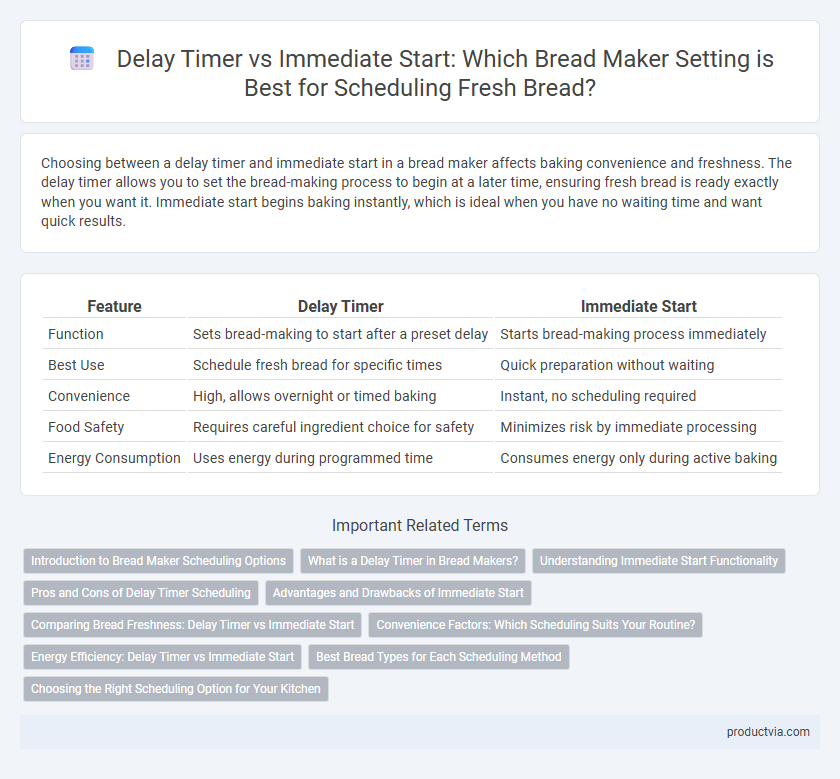Choosing between a delay timer and immediate start in a bread maker affects baking convenience and freshness. The delay timer allows you to set the bread-making process to begin at a later time, ensuring fresh bread is ready exactly when you want it. Immediate start begins baking instantly, which is ideal when you have no waiting time and want quick results.
Table of Comparison
| Feature | Delay Timer | Immediate Start |
|---|---|---|
| Function | Sets bread-making to start after a preset delay | Starts bread-making process immediately |
| Best Use | Schedule fresh bread for specific times | Quick preparation without waiting |
| Convenience | High, allows overnight or timed baking | Instant, no scheduling required |
| Food Safety | Requires careful ingredient choice for safety | Minimizes risk by immediate processing |
| Energy Consumption | Uses energy during programmed time | Consumes energy only during active baking |
Introduction to Bread Maker Scheduling Options
Bread makers offer two primary scheduling options: delay timer and immediate start, each catering to different baking needs. The delay timer allows users to set a future start time, ensuring freshly baked bread is ready at a preferred moment, ideal for early mornings or planned meals. Immediate start begins the baking process instantly, providing quick and convenient bread preparation without waiting.
What is a Delay Timer in Bread Makers?
A delay timer in bread makers allows users to set a baking start time up to 13 hours in advance, enabling fresh bread to be ready at a specific time without manual intervention. This feature controls the mixing, kneading, rising, and baking phases to begin automatically according to the programmed schedule. Immediate start, by contrast, begins the bread-making cycle instantly, requiring users to be present throughout the process.
Understanding Immediate Start Functionality
The Immediate Start function in bread makers initiates the baking process as soon as the ingredients are added, ensuring fresh bread is ready without any waiting period. This feature is ideal for users who prefer to bake bread immediately rather than scheduling it for later. Understanding the Immediate Start functionality helps in selecting the right mode for quick baking and optimal freshness.
Pros and Cons of Delay Timer Scheduling
Delay timer scheduling in bread makers allows users to program baking to finish at a specific time, providing fresh bread exactly when needed. It offers convenience and flexibility but carries risks such as yeast activation timing issues, which may affect dough rising and bread texture if left too long before baking starts. Immediate start ensures consistent results by starting the baking process right away but lacks the scheduling convenience of a delay timer.
Advantages and Drawbacks of Immediate Start
Immediate start on a bread maker enables the baking process to begin instantly, ensuring fresh bread is ready without waiting periods, which is ideal for spontaneous baking needs. However, this setting lacks the flexibility of a delay timer, limiting user convenience when planning bread preparation ahead of time for specific meal schedules. While immediate start guarantees minimal waiting, it may not accommodate early morning or late-night baking preferences without active user presence.
Comparing Bread Freshness: Delay Timer vs Immediate Start
The delay timer feature in bread makers allows for precise scheduling, ensuring bread is freshly baked at any desired time, which significantly enhances bread freshness by maintaining optimal dough rising and baking cycles. In contrast, immediate start initiates the baking process without delay, resulting in bread that is freshest only at the moment of baking completion but offers less flexibility for timed freshness. Comparing both, the delay timer provides superior convenience for consistent fresh bread throughout the day, while immediate start suits spontaneous baking needs without scheduled freshness control.
Convenience Factors: Which Scheduling Suits Your Routine?
Delay timer in bread makers allows for precise scheduling to have fresh bread ready at a specific time, enhancing convenience for busy mornings or planned meals. Immediate start options are ideal for users who prefer to bake bread on demand without waiting, providing flexibility for spontaneous baking sessions. Choosing between delay timer and immediate start depends on your daily routine and how you prioritize fresh bread timing versus baking immediacy.
Energy Efficiency: Delay Timer vs Immediate Start
Using a delay timer on a bread maker allows the appliance to operate during off-peak energy hours, reducing electricity costs and enhancing energy efficiency. Immediate start consumes electricity right away, which might correspond to peak demand periods with higher energy rates. Scheduling bread making with a delay timer optimizes power usage by leveraging lower tariffs and minimizing the environmental impact of energy consumption.
Best Bread Types for Each Scheduling Method
Delay timer is ideal for doughs requiring slow fermentation like sourdough and whole grain breads, enhancing flavor and texture by allowing extended rising time. Immediate start suits quick breads and basic white loaves, providing fast baking without fermentation delay. Selecting the appropriate scheduling method optimizes the bread quality based on dough type and desired baking time.
Choosing the Right Scheduling Option for Your Kitchen
Delay timer in a bread maker allows you to set a specific time for baking to start, ensuring fresh bread is ready exactly when you need it. Immediate start begins the baking process right away for quick preparation but lacks flexibility in timing. Selecting between delay timer and immediate start depends on your daily schedule and preference for fresh bread timing in your kitchen routine.
Delay timer vs Immediate start for bread scheduling Infographic

 productvia.com
productvia.com